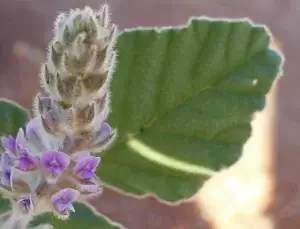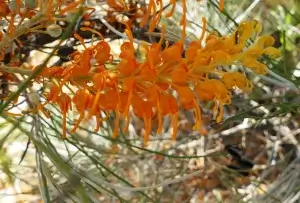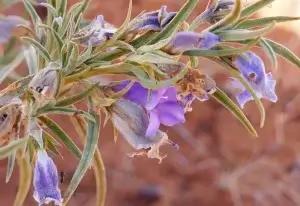

Issue 3, September 2024
This trip we ventured to the south east corner of Queensland starting at Miles, formerly known as Dogwood Crossing. Miles is situated on the Dogwood Creek and is known for its wildflowers, particularly following the first Spring rains in September. We were a little early but far from disappointed. There is a wildflower driving trail that passes through the Gurulmundi State Forest which is home to many endemic species, in particular the Calytrix gurulmundensis and the Micromyrtus carinata commonly known Gurulmundi heath myrtle. An excellent map with detailed written directions is available from The Historical Village Museum Information Center. Chinaman’s Lagoon, on the edge of town, also has a great bush walk and is the only place to find the Nymphaea gigantea var. Nervosea waterlily (which is a pink form of the native waterlily). Unfortunately we were there out of season, so missed it flowering.
Heading further west we stopped at the Roma Bush Gardens to find the Acacia pendula, Weeping myall, then on to Mitchell, situated on the Maranoa River. Stopping at the Tregole National Park in Morven where a large stand of the ancient and endangered Cadellia pentastylis, or the Ooline Tree thrives. Large numbers of the Cymbidium canaliculatum, black orchid were spotted throughout the walk, but again, we were there at the wrong time for flowers. A dip in the mineral spa at Mitchell is a must before heading on to Charleville.
Charleville sits on the Warrego River and has a very interesting bushland walk and a more manicured parkland to explore. The interesting Vortex Guns are housed here. They were used in an unsuccessful attempt in rainmaking during the horrific drought 1900-1902.
Also situated further south on the Warrego River is Cunnamulla, our next stop after having a quick look at the river ‘beach’ at Wyandra on the way. Here there is another very interesting bushland walk which is well signposted with plant identities.
Leaving Cunnamulla we headed to Thargomindah, stopping at Paddabilla Bore (a world renowned birding spot) and Eulo, home of artesian mud baths, and Kenny, the giant diprotodon – a giant wombat-like creature that once walked the earth in this area. Our camp for the night was at Tato campground on Jackson Creek, near the Jackson oilfields. Next morning it was off to Innamincka, passing through very green and ‘undesert like’ country. Throughout our journey we have seen a number of the Central Bearded Dragons, draped on fences, in the tops of dead trees, and lazing on rocks and the road, all in an effort to warm up for the day. Innamincka is just over the South Australian border and the camp is on the banks of Cooper Creek.
The vegetation has been changing along the way and there are now many more burr and thorn plants in evidence, many with beautiful flowers. Desert plants are called xerophytes; because they prevent water loss by storing water in their stems. Any leaves tend to be small and thick and covered with a thick outer layer with many modified into thorns to reduce water loss. Most are grey/green and have a ‘furry’ appearance. Some flowers are microscopic so it is important to keep a close eye on the ground.
Our next adventure was to traverse the Strzelecki Track, a mostly unsealed outback track of 472km linking Innamincka to Lyndhurst. Along the way we passed through the Moomba Gas Fields. We camped overnight where the Strzelecki Creek crosses the Track, passed through the Cobblers Sandhills (where the dunes are replaced by small eroded knolls, mostly with vegetation on the top), and Montecollina Bore (drilled in 1903 and forming a shallow wetland, surrounded by sand hills).

Goodenia collaris
After spending a night in Lyndhurst, we moved on to Marree which sits at the junction of the Oodnadatta and Birdsville tracks and is an important service centre for local cattle and sheep stations and these days as a tourist stop. Nearby is the Marree Man – a 3.5km geoglyph, depicting a hunter with a stick/boomerang in his hand. There is little vegetation here but magnificent scenery of the country surrounding Kati Thanda (Lake Eyre), Australia’s largest salt lake covering an area 144km x 77km and 15.2m below sea level.

After an incredible flight over Lake Eyre we headed off up the Birdsville Track, traversing the Strzelecki, Sturt Stony and Tirari deserts along the 517km route. There were many waterholes, bores, and wetlands along the way, as it has been a very wet year. We camped for a couple of days at the Mungeranie Pub which is a very popular rest stop along the track. The sand hills around the pub were all covered with flowers. The track was in reasonable condition but we were still happy to arrive in Birdsville, nestled on the Diamantina River.

Trichodesma zeylanicum
We spent a few nights in Birdsville, visiting Big Red sand dune and the iconic Birdsville Pub, before heading off again to Windorah (again on the Cooper Creek), through Betoota, and on to Quilpie, on the Bulloo River. From Quilpie we visited the Hell Hole National Park near Adavale. Surprisingly there were a group of pelicans in a small waterhole at Adavale and the waterholes at the national park were all full. Towns out this way are looking good and all working hard to make life easier and more interesting for the tourists – it works.

Teucrium racemosum
Nearing the end now, we headed back to Cunnamulla through Toompine, the pub with no town. The sides of the road were highly vegetated and the bushes along the way were all heavy with blooms. We also spotted many emu, counting over 100 along the way.

Thryptomene hexandra
Our last stop on this trip was at the Bowra Wildlife Sanctuary, owned and managed by the Australian Wildlife Conservancy (AWC). It lies in the mulga lands and is an important refuge for the birds and wildlife of the area. It is internationally renowned as one of Australia’s most rewarding bird watching destinations, but I was also able to find many wildflowers.

Wahlenbergia gracilis
This was a great trip to see the desert areas in full bloom and visit some of the more remote towns in Queensland. What a great experience. If you have any questions or would like to share your story, please visit the web page at thenomadsbotanist.com our Facebook page or email us at thenomadsbotanist@outlook.com




































